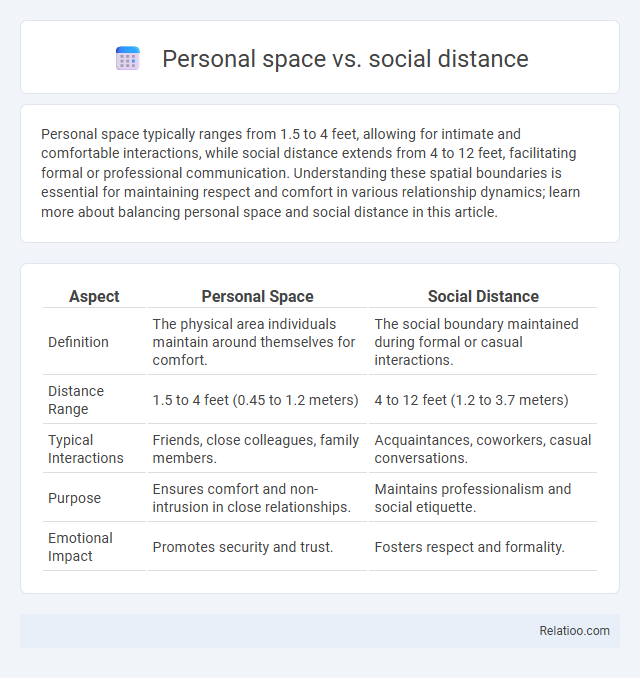Personal space typically ranges from 1.5 to 4 feet, allowing for intimate and comfortable interactions, while social distance extends from 4 to 12 feet, facilitating formal or professional communication. Understanding these spatial boundaries is essential for maintaining respect and comfort in various relationship dynamics; learn more about balancing personal space and social distance in this article.
Table of Comparison
| Aspect | Personal Space | Social Distance |
|---|---|---|
| Definition | The physical area individuals maintain around themselves for comfort. | The social boundary maintained during formal or casual interactions. |
| Distance Range | 1.5 to 4 feet (0.45 to 1.2 meters) | 4 to 12 feet (1.2 to 3.7 meters) |
| Typical Interactions | Friends, close colleagues, family members. | Acquaintances, coworkers, casual conversations. |
| Purpose | Ensures comfort and non-intrusion in close relationships. | Maintains professionalism and social etiquette. |
| Emotional Impact | Promotes security and trust. | Fosters respect and formality. |
Understanding Personal Space: Definition and Importance
Understanding personal space involves recognizing the physical distance individuals maintain to feel comfortable and secure during social interactions, which varies based on cultural norms, context, and individual preferences. Social distance refers to the broader physical or emotional gap between people in different social settings, influencing communication styles and group dynamics. Your awareness of these distinctions enhances empathy, respect for boundaries, and effective interpersonal relationships.
The Concept of Social Distance Explained
Social distance refers to the perceived or desired level of acceptance and interaction between individuals or groups, influencing societal inclusion and exclusion dynamics. Personal space pertains to the physical distance people maintain to feel comfortable during interactions, typically varying by culture and context. Preferences in social distance are shaped by psychological, cultural, and situational factors, affecting communication patterns and relationship formation.
Key Differences Between Personal Space and Social Distance
Personal space refers to the physical boundary individuals maintain around themselves to feel comfortable, typically ranging from 1.5 to 4 feet, while social distance pertains to the broader spatial zone from 4 to 12 feet used in formal or group interactions. Key differences include the emotional comfort associated with personal space versus the functional purpose of social distance in facilitating communication in social or professional settings. Preference in maintaining either space varies culturally and situationally, reflecting individual comfort levels and social norms.
Psychological Factors Influencing Spatial Boundaries
Psychological factors such as cultural background, past experiences, and personality traits significantly influence the establishment of personal space, social distance, and individual preferences in spatial boundaries. Your comfort level with proximity depends on an interplay between anxiety levels, need for control, and social context, shaping how close or distant you want others to be. Understanding these factors helps tailor interactions to respect personal boundaries and enhance social harmony.
Cultural Variations in Personal Space and Social Distance
Cultural variations in personal space and social distance significantly influence your comfort and interactions, with some cultures valuing close proximity while others prefer greater physical distance to maintain social boundaries. Personal space reflects intimate comfort zones, often smaller in collectivist societies, whereas social distance governs formal or public interactions, typically larger in individualist cultures. Recognizing these differences helps you navigate social contexts respectfully and strengthens cross-cultural communication.
Effects of Technology on Social Interactions and Space
Technology reshapes personal space and social distance by blurring physical boundaries through virtual interactions and digital communication platforms, influencing how individuals perceive and maintain relational proximity. Online social networks and video conferencing reduce dependency on physical presence, allowing preferences for interaction space to become more flexible and personalized. This shift impacts social behaviors, with increased reliance on technology altering traditional cues and expectations around personal and social distances.
Personal Space in the Workplace
Personal space in the workplace directly impacts your comfort, productivity, and interpersonal relationships by defining the physical boundaries you prefer between yourself and colleagues. Unlike social distance, which relates to broader cultural or situational norms, personal space is an individual preference that varies based on personality, role, and context. Respecting these personal space boundaries helps maintain a professional environment and reduces stress, improving overall workplace satisfaction and collaboration.
Social Distance in Public and Private Settings
Social distance varies significantly between public and private settings, with public environments often requiring greater physical space to ensure comfort and safety. Your comfort with social distance is influenced by cultural norms, the nature of the relationship, and situational context, with closer proximity typically reserved for private settings. Understanding these distinctions helps maintain respectful interactions while honoring personal space preferences.
Navigating Boundaries: Tips for Respectful Interaction
Navigating boundaries requires understanding the differences between personal space, social distance, and individual preferences to ensure respectful interaction. Your ability to recognize cues like physical proximity and comfort levels helps maintain a balance that respects others' need for space while fostering positive communication. Clear communication and sensitivity to nonverbal signals empower you to adapt your approach, promoting mutual respect in social and professional settings.
The Role of Personal Space and Social Distance in Mental Well-being
Understanding the role of personal space and social distance is crucial for Your mental well-being, as maintaining appropriate boundaries can reduce stress and enhance emotional comfort. Personal space regulates nonverbal interactions, while social distance facilitates social connection and a sense of security. Respecting these preferences improves psychological health by fostering feelings of safety and social acceptance.

Infographic: Personal space vs Social distance
 relatioo.com
relatioo.com